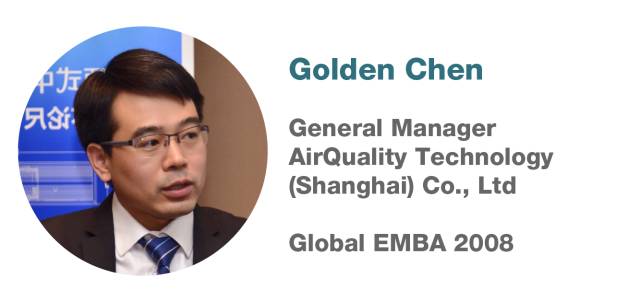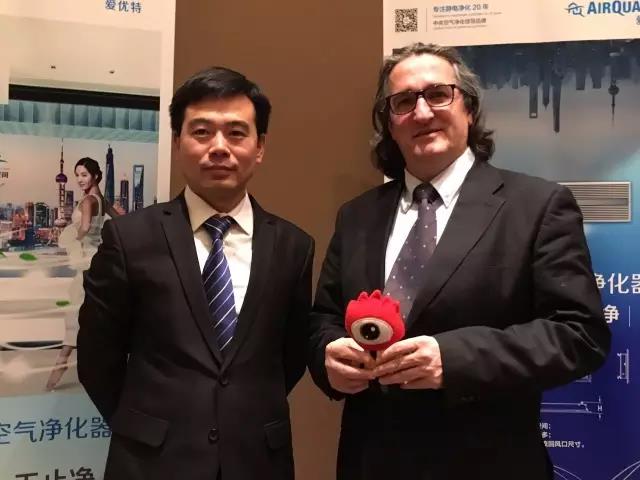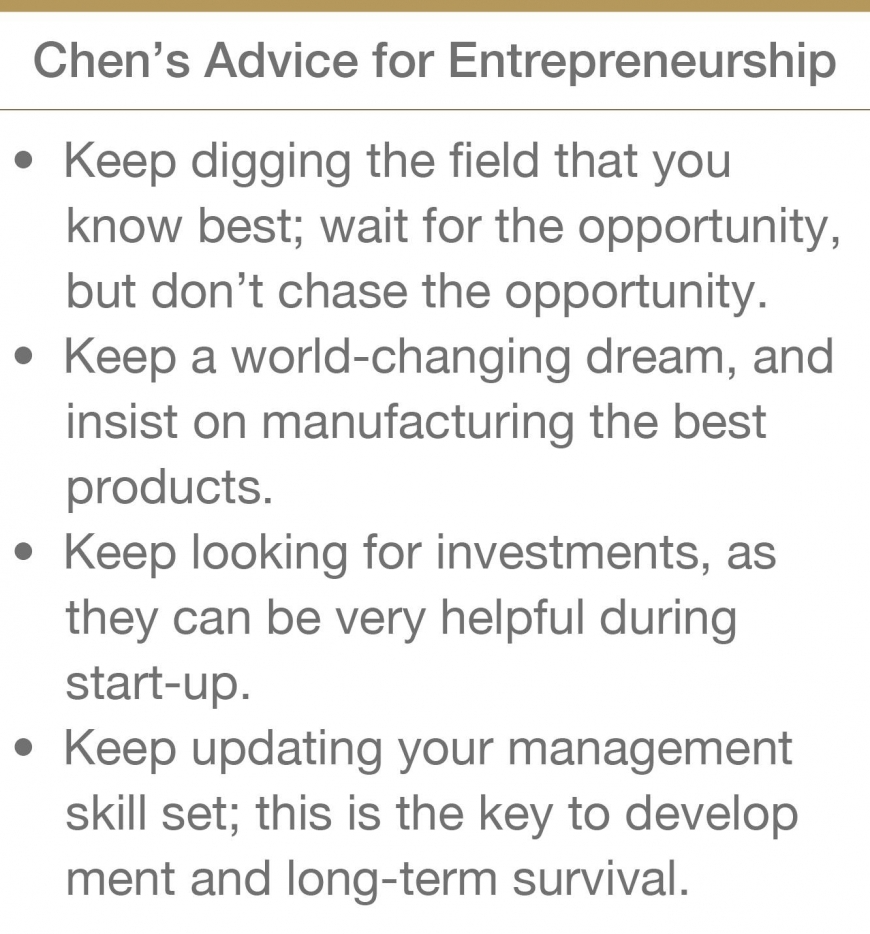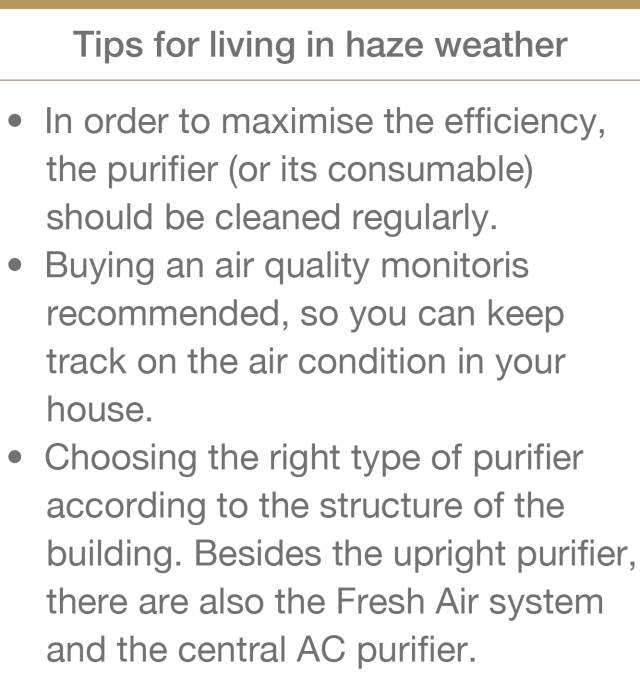Beating the “Haze”: Turning pollution into commerce
Click Here to Read More Alumni Stories
Nowadays, when a major political event is imminent, the media will focus on the air quality more than ever. Having witnessed the “APEC-Blue” and “G20-Blue”, they have already started speculating on air quality and “haze” and whether it will affect this year’s Lianghui.
Checking the AQI or PM 2.5 figure has become a norm for many people these days.Ironically, such an act would have been almost unimaginable five years earlier.
To most of us, the starting point of our “haze memory” falls in the winter of 2012/2013. Severe haze enveloped Beijing and Shanghai during that time, receiving full media coverage, analysis, and public discussion. Fear, anger, complaints and concern were everywhere, but ultimatelywe could only accept the reality: to fix the haze entirely would require 20 or 30 years or evenlonger.
Though we cannot change the macro-environment, the “micro” one is still in our hands. Upon realisation of this fact, the demand surged for anti-pollution masks and indoor air purifiers. This was a wind-fall opportunity for many people, including Golden Chen.

However, Chen was lucky compared to those who were caught unprepared. A year before, he had already foreseen the opportunity, and, with his classmate, founded the AirQuality Air Technology company. The company quickly found firm ground in the market, and started B2B services to luxury apartments and five-star hotels such as Wanda, Vanke and Greenland.
Chen's business background was crucial to his eventual success. In 1997, Chen graduated from university, and entered the air-conditioner business. He was a patient man and remained in that business for more than a decade.
Before his own business kicked off in 2011, Chen was working in a US company, which no longer valued its purifier business. Thanks to his own familiarity with the Chinese market and business trends, Chen observed the development of a small but high-end market for air purification service. This demand was stimulated by three key factors: the2003 SARS crisis; the 2008 Beijing Olympics; and the 2010 Shanghai EXPO.
Just a few years earlier, Chen’s entrepreneurial mind was not very developed. He was accustomed to the professional manager “mode” and therefore in 2008, undertook to do a Global EMBA with the intention of improving his management skills.
However, while at CEIBS, Golden Chen met the right person, in the right place at the right time.
He started to have an interest in entrepreneurship. After two years of studies, Chen’s abilities in macro-analysis, business strategies and tactical planning improved massively. He became more confident and brave in facing an uncertain future.
CEIBS was also where Chen met Roca Santiago. They were not only classmates, but also team members, and thus became good friends. Santiago came from the electronic transformer business where he learned about electrostatic technology. Chen kept exchanging ideas with his Spanish friend, and thus acquired more and more knowledge of European purificationtechnologies and their brands.

Golden Chen and Roca Santiago
By now, everything was ready. Upon receiving investment from the Spanish firm Herver-9 S.L, Chen and Santiago founded the AirQuality Air Technology (Shanghai) Co., Ltd. From then on, Chen left the professional manager pathway, and became an entrepreneur.
Compared with those who always complain about the start-up experience, Chen said “those times were good times”. They did not have many employees, but managed to form a good company culture; they did not receive many orders, but kept earning good profit. The company quickly covered its start-up costs, and cash flow has always been positive since then. “In contrast to big-company bureaucracy, the environment here is much better.”
Rocketing in the haze
2013, Chen’s mobile number became like a hot-line. Every call was from friends asking about haze and air purifiers. Chen realised that the time to launch had arrived. But he knew that, if the company wanted to grab this opportunity and a sizeable market share, its market orientation would have to be altered from “small and nice” to something else.
Finally, Chen made his decision. However, it is impossible to make a small firm into a medium-sized company overnight. To begin with, they needed money. “Funds are massively helpful during the start-up period, so one should always fight for these investments.”
As a CEIBS alumni, Chen first thought of the Business School. He left a message on the Alumni Entrepreneurship Forum: “Seeking investment — 3 year old firm, dedicated to improving air quality”. He received several responses in a short space of time.
With the help of DreamCapital, a funding consultant founded by a CEIBS alumni named Tang Wenjie, Chen quickly met 10 VC's, from which he chose IFCE (International Fund for China’s Environment). In 2014, the company finished its ‘A’ round with an estimated value of more than 100 million RMB.
Using the investment, Chen moved the company from Pudong to Baoshan District, where its own factory, research centre and exhibition centre were built. The team expanded swiftly to 80 people, while the number of departments increased.
In the start-up world, there is term called “A-Round curse”. It refers to the ultimate failure of many start-up firms. One of the important causes is over-expansion, which can drive up labour costs and lead to a management crisis.

At that time, Chen also experienced a similar period of shocks: “When a firm is expanding quickly, the biggest challenge is human resource management.” Besides hiring a CEIBS alumni as the HR director, Chen also kept updating his HR knowledge. He participatedin CEIBS’s HR Elite Camp and studied with a group of senior HR practitioners.
“Management is the key to development, and the basis of long-term survival.”With this in mind, Chen never stops studying management. “New problems will keep coming every day. Sometimes I go back to my lecture notes for answers, sometimes I attend related lectures at CEIBS, and sometimes I discuss issues with others on Wechat.”

Challenge = Opportunity
During the same period, Chen was also baffled by another question: with what technology can he get ahead of the market?
Immediately after the birth of the “Haze market”, many companies rushed in for a share. They quickly introduced products, of which consumers had nearly no judgement criteria with which to make a comparison. Chen did not join this “fiesta”, but started his analysis: after the early period of irrational consumption, the consumers will eventually become quality-oriented; therefore, what he needs to do is to get ready for a rational, bigger market, rather than a short-term one.
With this thought in mind, Chen and his research team started their work on a design that could satisfy the demand for clean air.
They noticed two challenges:
First, was the consumables. At that time, the market dominator was replacement-required air purifier, the filter of which needed to be changed twice a year. Obviously, its maintenance cost was considerable.
Second, was the limitation on physical space for household air purifiers. These purifiers are independent “points” that take up huge space, produce noise, but can only purify air within a limited range. Such products were becoming increasingly unable to suit the consumer demand.
A purifier can become both economical and environmentally friendly if it needs no replacement parts and has a central control unit. The research team of AirQuality started their exploration on these two areas. “Central air purification” was first raised by AirQuality in the industry. This is a concept that integrates all air purifiers in a building unit, in order to purify with full-coverage, full-functions, and in full-time.
In 2015, AirQuality impressed the industry with its innovative micro-electrostatic technology. That year is also called “Year 1” for China’s micro-electrostatic air purification industry. Using this technology, AirQuality achieved zero consumables: filters can be cleaned with water. More importantly, the company finally realised the concept of “central air purification”.
Many famous buildings have since been equipped with AirQuality’s central air purification system, for example: Kempinski Hotel (APEC Conference venue), Hangzhou Xizi Hotel (G20 main-site), Disney Shanghai and CTF Financial Centre (Guangzhou).
Haze will eventually disappear, but good air quality is an enduring goal
After experiencing an HR crisis and achieving a technological breakthrough, in 2016, AirQuality finally entered a stable period of development. The management quality has improved significantly, and the team structure stabilised. Chen has begun to plan the future of his brand.
With the boom of the “haze market”, demand for AirQuality’s products is both rising. Proportionally, however, household demand is surging. Chen said that, in 2017, AirQuality would walk even faster in the household market, while continuing to promote upright purifiers in the “Red Sea market”. In particular, AirQuality will focus on the field of transforming return-air inlet into purifier in the air-conditioning (AC) system. This is because, as Chen said, that AirQuality still has no major competitor in this area.
How big is this market? According to Chen’s estimation, China now has 200 million return-air inlets. If the transformation of each needs 3000~4000 RMB, then the market size will be 600 to 800 billion RMB. This market is even more profitable if we consider the fact that, customers who own central AC are usually high-end: they pay more attention to health and air quality.
On the future, Chen shared two of his forecasts.
First, haze problems may peak as late as 2030. This is determined by power usage, human consumption and car ownership. Therefore, the “haze market” will continue to exist for a certain period of time. Therefore, AirQuality will continue its research into air purification, and start to focus more on customer experience, in order to upgrade itself from a product business to a service business.
Second, when the haze problem is eventually solved, the air purification industry can change its focus to pollution prevention. This is actually what many Northern European companies are pursuing now. In fact, AirQuality has already introduced products in the field of dust cleaning, kitchen air quality and car emissions, among others.
“The market for air purification is very big, even if we consider only the pollution prevention business. Air quality in some countries, such as Japan and USA, is already very good. But people still want to filter out pollens, moulds, and unpleasant smells. Haze will disappear eventually, but good air quality is an enduring goal.”















